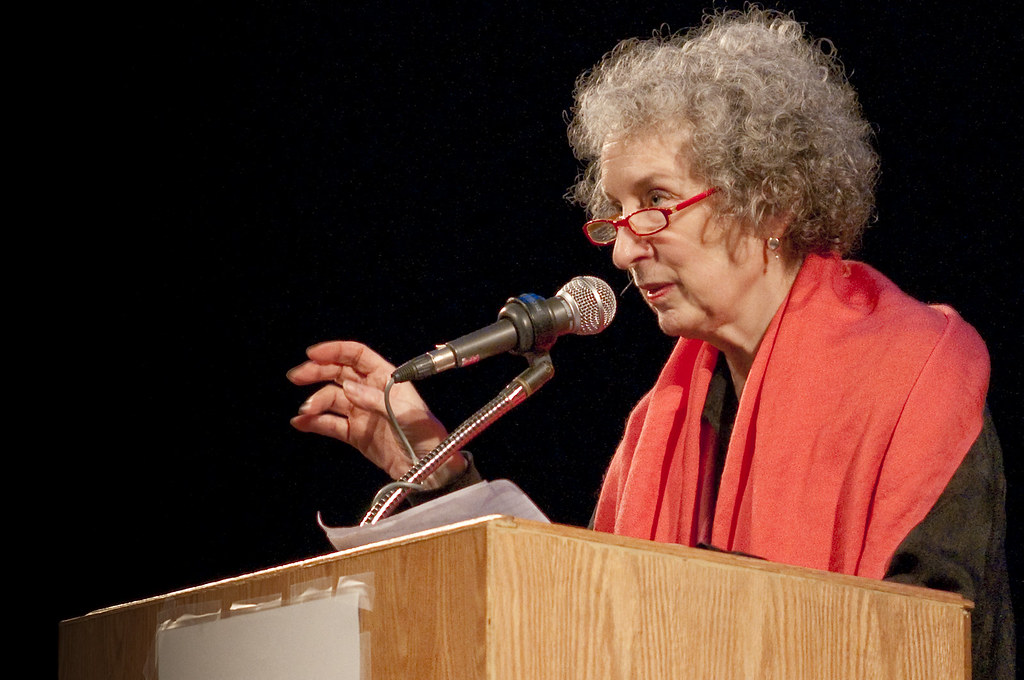Margaret Atwood’s Top 13 Writing Tips
Margaret Atwood has written over 50 books of fiction, essays, and poetry.
Her novels like The Handmaid’s Tale and Oryx and Crake have not only garnered her awards but have also painted a speculative reality for readers — a world that is different and darker than our own.
I recently had the opportunity to watch Atwood’s MasterClass on writing. (MasterClass is a subscription program where for $180/year, you can watch high-quality courses from experts in various fields.)
Here are the top 13 lessons I learned from her MasterClass:
1. Immerse yourself in your topic
“Nobody knows where ideas come from, but let us say, if you immerse yourself in something, whether it be music, painting, or writing…you are going to get ideas about it. But you have to do the immersing first. You’re not just sitting there, waiting for lightning to strike.” -Atwood
Atwood’s advice is similar to an old quote from W. Somerset Maugham: “I write only when inspiration strikes. Fortunately it strikes every morning at nine o’clock sharp.”
Determination — not inspiration — is the chauffeur of creativity. We must buckle up and get to work before we can expect to receive any flashes of brilliance.
If you’re struggling to get started, find a way to immerse yourself in the topic. If you’re writing about nature, go spend some time in nature. If you’re writing leadership advice, listen to a podcast or read a business book. If you’re writing a novel, meditate and put yourself in the mind of one of your characters for a bit. And above all, start writing. That’s when the ideas really begin to flow.
2. Conduct TONS of research
“It’s best to check your facts and factoids and even such things as when did people start using plastic garbage bags? What color were the refrigerators in 1960? When were pantyhose invented? You may think you know these things, but you really should go back and double-check.” -Atwood
Atwood conducted hours of research for her novel Alias Grace, which is based on two notorious murders in 1843. For her book The Handmaid’s Tale, she researched totalitarian sects in Romania, military leadership in Nazi Germany, cults and arranged marriages, and the psychology of brainwashing.
In fact, every core element of The Handmaid’s Tale is based upon a real historical event. Atwood says she didn’t want any readers to be able to dismiss her story as “unrealistic,” so she used fact to create stronger fiction.
“It’s important to get those details right because if you get them wrong, it throws off the reader’s belief in your story,” she explains. “Your goal is to keep your reader believing in your story even though both of you know it’s fiction.”
3. Engage all of the senses
“[Movies] can’t do smell yet, and we ought to be grateful for that.” -Atwood
It’s tough to top the visual experience of a blockbuster movie. The writer’s best opportunity to engage readers is to appeal to every one of the five senses, including the ones that don’t work well on the big screen: smell, taste, and touch.
If you want the reader to feel what it’s like to sit in the bleachers at a baseball game, then enlist the help of the sun to drain your reader’s lips of moisture while wetting their brow with sweat. Waft the buttery scent of popcorn toward your reader as they slurp down a refreshing 20-ounce Coke. And help the reader envision the cannonball blast of a baseball colliding with cleanup hitter’s swing as they hear the CRRRAAAACKKK of the bat.
4. Determine what process works best for you
“I’m more of a downhill skier. I try to go as fast as I can and then I have to backtrack a lot and fill in revisions.” -Atwood
Atwood explains, “There is no set of surefire rules that are going to work for everyone.” Many writers will try to tell you that you need to do X, Y, or Z, but those things may or may not work for you.
Every writer’s process is different, so it’s important to learn what works for you. Experiment. Try writing while listening to music, without listening to music, after going on a long run, after going on a short walk, at the start of the day, and at the end of the day. Try writing quickly and try writing slowly, editing as you go.
No one can tell you what will rev your creativity engine. Try a few different keys in the ignition to see what works for you.
5. Defy expectations
“A story needs a break in a pattern to get it going…If everything is perfect all the time, there isn’t a story.” -Atwood
No one wants to read about characters who always behave as expected. If the reader can anticipate everything you’re going to say, why should they bother reading what you write?
Atwood recommends writing unstable characters: “Dangerous and unstable characters — characters we can’t necessarily predict, characters we don’t know whether they’re telling us the truth or not — they hold our attention in a way that [a well-behaved character] doesn’t.”
Here’s a quick thought exercise. From these popular stories, which character did you think was more fun to read about?
- From Sherlock Holmes: Predictable military man John Watson or the ever-eccentric Sherlock Holmes?
- From The Hunger Games: Level-headed Peeta Mellark or the unpredictable Katniss Everdeen?
- From Fight Club: The unassuming narrator or the mysterious Tyler Durden?
Surprise your readers. Don’t give them the run-of-the-mill Dick and Jane stuff. Create characters who will do unexpected things on the page.
6. Write some unlikeable characters
“Likability is a factor when you’re choosing a roommate, but it’s not necessarily a factor when you’re creating a living character.” -Atwood
Do you ever read a book and begin to hate a character so much that your nose crinkles up a bit every time you see that character’s name on the page?
Take the Harry Potter series, for example. J.K. Rowling created many likable characters: Harry, Hermoine, the entire Weasley clan except Percy, etc. But the series is bolstered by the strength of unlikeable characters like the Malfoy family, Voldemort, Bellatrix Lestrange, and Dolores Umbridge. Those nose-crinkling characters are every bit as powerful as the lovable characters — arguably more so.
Give your readers characters to love and characters to hate.
7. Go for a walk
“You also may find that ideas come to you when you’re walking that don’t come when you’re straining and struggling.” -Atwood
Charles Dickens, Henry David Thoreau, Ernest Hemingway, and countless other writers have used walks to spur creativity and eliminate writers’ block.
“It’s worth the time to take an hour’s walk before writing,” according to Orson Scott Card. “You may write a bit less for the time spent, but you may find that you write better.”
This is another tip that works for some people but not for others. Remember, you’ll need to find what works for YOU. Any advice you get from other writers should be tested against your own experience.
8. Build your toolkit of stories
“If you are interested in writing and having a large toolkit of stories, [I suggest you read old classic stories] because those stories have been building blocks for a great many writers before you.” -Atwood
Atwood recommends reading books like The Bible, Grimms’ Fairy Tales, Greek mythology, and other stories that have earned a shelf space in the pantheon of literature and history.
She explains that plotlines from these ancient stories are woven into modern-day literature, and many writers creatively play off those motifs in their work.
“In order to get the joke, you have to know the original,” says Atwood. And if you want to learn the art of storytelling, there’s no better place to start than with the stories that have survived for centuries.
9. Be patient
“Any form of human creativity is a process of doing it and getting better at it…[Writers] don’t usually peak in their 20s. It’s usually quite a lot later on. Why is that? Because writing is about people and story is about people, and you know more about people and their stories as you get older…you see more and you experience more.” -Atwood
Atwood talks about how older writers can remember what it was like to be younger (e.g., a writer who is 65 can remember what it was like to be 25), but younger writers cannot remember what it’s like to be older. She credits that as one of the reasons why age is an asset for a writer.
Every year you live not only provides another year of perspective, but it also provides another year of stories to draw upon in your writing.
Another way of looking at this concept is to use it as an opportunity to build patience. Do not expect instant success. Put your head down. Invest the time to write, learn, and improve.
10. Experiment to learn what will work in your story
“Let’s speak of [writing] in terms of furniture arranging in your house. You put the sofa there. Hmmm…I dunno, it might look better over here. Hmmm…maybe it’s the wrong sofa. Maybe we could put this sofa upstairs and then this other different one here. Sometimes you take a turn down a corridor and it’s a dead end.” -Atwood
Atwood says that writing is problem-solving. Rather than setting out with a perfect plan in mind, writers often experiment to see what works.
In this way, writing is similar to many other fields. Comedians test jokes on small crowds to gauge their reaction. Chemists experiment with different proportions to see which mixture will achieve the desired outcome. And writers put pen to page to test which concepts, characters, and plotlines will make the cut after revision one, two, ten, or one hundred.
Don’t be afraid to experiment in your writing. Get your ideas down on the page, where you can wrestle with them to see if they endure the strain.
11. Re-vision your work
“Pretend you’re a reader. Start on the first page. Is it a good enough first page to hold your attention? Are you gonna turn the page or not? If the answer is not, you need a different beginning. So, ‘revision’ means ‘re-vision.’ You’re seeing it anew.” -Atwood
Great writing requires seeing your work from the reader’s perspective. It requires psychologically distancing yourself from your work so you can evaluate it as a disinterested third-party.
Atwood had to change the beginning of The Handmaid’s Tale numerous times until she found one she liked. She realized that the earlier versions didn’t grab her enough as a reader, so she had to re-vision the introduction.
“If you cannot get that reader through the first page, they will never read the brilliant insights into life that are on page 75,” says Atwood. “So what you want on the first page is something that is going to beckon the reader in. The first page is the gateway.”
Find the appropriate gateway to introduce your readers to the story.
12. Write because you love it
“When I was starting to write, none of us thought we were going to have careers. We thought we were going to have vocations, which is quite a different thing. So our idea of being a writer was not a six-figure contract. It was the garret in Paris with the absinthe and the tuberculosis and being penniless and unknown but dedicating yourself to your art.” -Atwood
Atwood didn’t set out to become a famous writer or even a profitable one. She set out on the path knowing that it would be arduous yet worthwhile. She began writing because she couldn’t NOT do it.
“People get news of the occasional writer who gets this fabulous contract, and they think that’s the norm,” says Atwood. “But it isn’t. The norm is that most writers don’t make a living out of their writing.”
Somewhat tongue-in-cheek, she explains that there are four types of books:
- Good books that make money
- Bad books that make money
- Good books that don’t make money
- Bad books that don’t make money
She says the first three possibilities are positive outcomes, so you just want to avoid the fourth option. But even if you write something that isn’t wonderful (as is bound to happen), you will have learned from the experience and hopefully enjoyed the process.
13. Make the final judgment call
“When push comes to shove, the buck stops with you. So whoever’s advice you may have taken, whatever alterations may have been made, what is on that page is going to be considered your work.” -Atwood
Atwood lost a book contract for one of her early novels because she refused to change the book’s ending to meet her publisher’s demands. She forfeited money and an early notch in her literary belt, but she retained her artistic control and the integrity of her book.
There’s a fine line between getting feedback on your work and surrendering your work to another person’s opinion. Editors are great, but the work is ultimately yours. After all, your name will be on the cover or the byline. Solicit feedback on how to improve your work but retain control of your piece.
The tips above will help you build stronger stories and characters. Now it’s up to you to put them into practice.
Happy writing!






